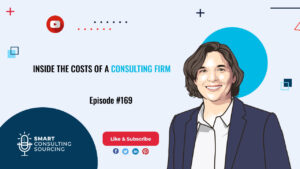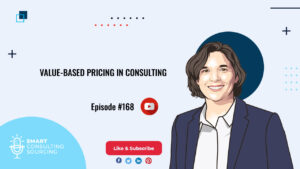Hello and welcome to episode 67 of our podcast: Smart Consulting Sourcing, THE podcast about Consulting Procurement.
My name is Hélène, and I’ll be your host today.
Each week I’ll give you the keys to better use, manage and source consulting services.
In Last week’s episode, I gave my definition of consulting.
So what is consulting? I see it as a project-based work organization with dedicated teams and little interdependencies with the rest of the organization.
Consulting is a very broad term, and the lines are blurring more and more with emerging industries such as Digital and Fintech.
You don’t need to adopt my definition. But you need to make sure that everyone in your company shares YOUR definition. So take the time to create the taxonomy of what you consider as “consulting services”.
Even better, write a guide for your executives explaining how they should work with Procurement depending on the type of consulting they need.
Today, I wanted to talk about consulting fees and rates. But first, let’s have a look at the cost structure in a consulting business.
What is the cost structure in consulting?
A cost structure is a cost breakdown of a business. And this cost structure is very important because it’s the basis on which a consulting company builds its price/rate, and therefore its margin.
People are the most important cost for any Consulting Firm, regardless of its size. It’s only natural since consultants are the service. Consulting Firms spend a lot of money on attracting and keeping talents. But non-partner consultants are often considered as fixed costs.
Overheads can account for a significant quantity of the overall costs for small and medium-sized businesses. Top consultancies have invested in creating a distinctive address and headquarters as part of their brand.
They also present an almost balanced ratio between consultants and non-consultants in their staff. Obviously, boutique consultancies and independent consultants will be much leaner on this cost category.
Once you’ve paid for employees and overhead, the next cost center on the list will be marketing and sales. Developing a brand, gaining recognition, and getting thought leadership out there are all essential aspects of generating leads and solidifying a company’s position. This area may be particularly limited to small boutiques.
Indeed, the consulting overhead structure is so basic: fixed expenses are restricted to a few overhead and SG&A costs, with the major cost being consultant salaries.
If you want to make money, all you have to do is use your consultants enough to cover these three categories, and any additional turnover beyond this limit will fill the pool for bonuses for partners and dividends for shareholders.
How are the consulting costs built?
Now let’s have a look at how they build their costs…
The time spent on a project is the major driver of cost for consultants since they are mostly selling their time. The price is usually calculated as the product of the daily rate per the number of days worked on the job.
Another key consideration is the team’s make-up. The difference may be quite significant. Between a seasoned partner and a recent graduate, you can anticipate a fivefold increase in price.
Another factor to consider is how much time they spend on the project. A full-time assignment is pretty straightforward: the Consultant is required to be onsite for the majority of the time.
Part-time assignments of highly experienced consultants can have a large impact on the cost and be extremely difficult to track. Many of you have without doubt already seen the team of specialists in your proposal who were supposed to work for 10% of their time but never showed up.
In the same way, team members should be ramped up and down in accordance with distinct phases.
In most cases, the price for Consulting Projects is driven by a client’s industry. At the high-end of the spectrum, Financial Services or Energy, Consultants charge a premium, whereas at the low-end are the Non-Profit Organizations.
As I said before, Consultants are selling their time, which is essentially the access to specialized knowledge and execution capacity for a certain period.
The amount of time available for billing is the production potential of a Consultancy. Every day that isn’t billed is similar to an empty airplane seat. As a result, the fee structure is generally geared towards maximizing utilization rates.
What are the different consulting fees?
Now let’s have a look at the different fee structures:
For smaller projects or exploratory phases, the Consultant can propose a negotiated daily rate. The total fee is then be calculated based on the real number of days spent on the project.
But The Flat fee is the most common fee structure for large projects. The Consultant will evaluate the work to be done and the deliverables to be prepared, and define the expertise and time needed to deliver the project. Afterward, two approaches are possible: taking the workload-based approach using daily rates or using this as a reference but price based on the value to the end client.
But you also have the Performance-Based Fees also called success fees that are linked to the achievements of pre-defined objectives. It is particularly effective for projects when the results can be easily measurable such as cost reduction, or top-line improvement. This often takes place as a bonus on top of a flat fee structure.
There are more occasional fee structures:
A retainer, for instance, is a monthly fee negotiated with a client based on a certain number of hours of support per month. This fee structure is mainly used by coaches or trusted advisors.
Equity-based Fees are often used with fast-growing start-ups that have little cash upfront or in case of turnaround situations. It is then up to the Consulting Firms to Adjust the resources to balance risk and value creation.
Finally, Percentage-Based Fees are calculated as a percentage of a project or transaction amount. Often used for M&A projects for instance where the consulting firms play at the time a facilitation and brokerage role.
But, project fee structures might be a mix of these fee structures, such as a retainer with a set daily rate once the monthly hours requirement is met, or a flat fee with an added performance-based bonus.
Depending on the scope of your project, your organization and the context of your project, you can build the fee structure that best fits your needs.
You know now why it is so important to understand the cost structure of a consulting firm and how consultants build their prices.
And that marks the end of our podcast folks. Next week, I’ll talk about how to work with consultants. What should you do once the consulting agreement is signed? How to manage the project and who does what?
Hope to see you next Thursday!
If you want more episodes go to podcast.smartconsultingsourcing.com.
And if you have any questions, or want to learn more about what we do at consulting quest, just send me an email at helene.laffitte@consultingquest.com
You can also have a look at our website consultingquest.com to know more about our book and download free templates & guides to improve your consulting sourcing.
Bye and see you next week! Au revoir!







